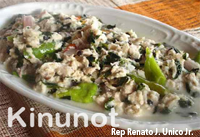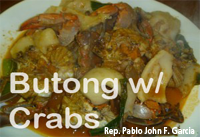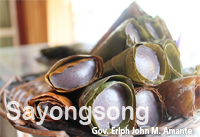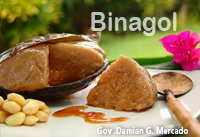
Do you believe that the fiercest man eating predator of the deep, the shark and stingray, scampers away in terror upon seeing a diver with a bunch ofmalunggay leaves in his hand? The Story is told that Donsolanons are "kinunot" connoisseurs. Go to the marketplace in late afternoons and find an array of kinunot dishes from shark meat to manta/sting rays laid out ready for a sampling fest for prospective customers, bystanders, kibitzers taking advantage of free 'tastings'. Filipino fishermen caught a rare species of shark and went ahead and ate it, probably with a cold San Miguel too. Well, what’s done is done – so you may as well know what all the fuss was about! *Picture a group of Filipino fishermen with fat bellies and toothpicks hanging out of their mouths saying “Whua? What’d I do?*

Visayan cooking is generally simple. Meat or fish is merely boiled with vegetables and spices to prepare a dish called tinola. Sometimes, fresh coconut milk is added to tinola to make a new dish called utan. When fish or meat is barbecued, it is called sinugba. Boiled vegetables mixed with ginamos (salted fish or shrimp paste) and fresh coconut milk are served as kinilaw (literally, "eaten raw"). Now, we will discover how other recipe Cebuano has. Seemly same as the great and well-known Pinakbet but with a twist! Let's know more about what's the secret of this awesome and mouth-watering dish you surely love! Start up with

my longtime FB friend Jun, who I just met for the first time a few days ago when I went to Surigao City, told me when I asked him what are the delicacies in the city. The name, in itself, is already intriguing but for Surigaonons, refers to cone or tapered shape.
Whenever I do travel, checking the local delicacies is one of the must things to do. It is one way of getting to know more of the place and for Surigao City, the sayongsong, is said to be only found in the province, especially in Barangay Ipil near the famous and unusual pebble beach.

Binagol, moron, sagmani…
Binagol (sweetened taro pudding with nuts) is a popular delicacy produced by the municipality of Dagami, Leyte. It is made from talyan - a root crop species like gabi that grows and is imported from Palapag, Northern Samar. Mixed with eggs, coconut milk, sugar, butter, nuts and chocolate, it is packaged and steamed using banana leaves and polished coconut shells called “bagol,” hence the name “binagol.”


